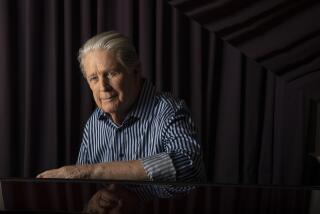Risk of Compact Disc? It Dulls the Raunchy Edge of Rock
- Share via
The compact disc is ruining rock ‘n’ roll.
Longtime rock fans who look for substance and inspiration in their music might blame rigid radio formats or the bottom-line business mentality that increasingly dictates which acts record companies sign and promote.
But I know it’s really the CD.
More than simply a technological breakthrough, the CD is altering how and why people listen to music. More and more, unfortunately, it’s for the sound, not the content.
The same thing is happening in jazz and classical music, but it’s particularly disturbing in rock, which has always depended more on maverick spirit and attitude than on instrumental proficiency or technical excellence.
You want to hear a great guitarist? Listen to Segovia. Want to hear a great rock ‘n’ roll guitar? Put on the Stones’ “Satisfaction.”
But compact discs chip away at this cornerstone of rock. If you have a CD player, or know anyone who does, what’s the first thing you always talk about?
“Hey, I just picked up the Beatles’ ‘Abbey Road’ CD. Doesn’t it sound great?”
CDs are spreading fastest in the upscale ages of 25-40, giving rise to Yuppie Rock, a sonic-conscious school that tends to turn up its nose at anything as technologically primitive as the recently released “Complete Million Dollar Quartet” sessions, recorded at Sun Records in Memphis one day in 1956 when Elvis Presley, Jerry Lee Lewis and Carl Perkins joined forces for some spectacular rock, country and gospel music-making.
Would the Big E--whose raw, explosive sensuality defined rock ‘n’ roll--have approved of a recording medium as pristine as the compact disc? Probably, but then Elvis also thought the best record he ever made was “It’s Now or Never.”
However great CDs sound, somebody is missing the point in trying to make Sam the Sham & the Pharaohs purer by digitally remastering their “Greatest Hits” for CD. A trash-classic like “Wooly Bully” was meant to be played on a grungy old record player and sounds even better if you’ve just dripped enchilada sauce all over it.
Worse, this attitude is spilling into live music. Recent tour stops in Orange County by Steve Winwood and Sting reinforced the notion that purveyors of Yuppie Rock are equally if not more interested in sonic quality than in lyrical or musical inspiration.
Other favorites among the CD-votees come to mind: Dire Straits, James Taylor, Dan Fogelberg, Bruce Hornsby--performers whose concerts often seem more like audiophile showcases than examples of rock’s true, thumb-your-nose-at-the-world spirit.
At Winwood’s show here, it was easy to be seduced by the exquisite detail from each musician: the punch of the bass, the sock of the drums, the airiness of an acoustic guitar. Without a second thought you could lean back, lock into the groove and--in the words of his latest single--”Roll With It.”
Same with Sting. While his songs are melodically inventive, the lushness of the sound doused any fires Sting might have hoped to ignite in the hearts or minds of the crowd.
In neither case did the musicians seem to connect and mutually inspire one another--the way any good garage band will.
There’s a sort of nebulous feel-good philosophy in Winwood’s songs. Sting’s socially and politically topical compositions have more lyrical bite, but in either case--with their emphasis on comforting, state-of-the-art sounds--it was far too easy to flip the mind’s “off” switch and sink down into the aural bubble bath.
That’s why last Sunday’s concert by Bob Dylan, another icon of the yuppie generation, was so reassuring, despite--or perhaps because of--its inconsistencies.
Ever the provocateur, Dylan came on stage with a prototypical rock lineup--two guitars, bass and drums--and played through a small battery of old Fender amplifiers that probably cost one-fiftieth of the spare-no-expense stage setups used by Winwood and Sting.
Dylan slammed and plowed his way through several of his best-known and best-loved songs, redesigning arrangements and restructuring melodies so radically that it was impossible for the audience to drift off into the dead zone of nostalgic familiarity.
And when he benched the bassist and drummer and sang several songs backed only by his and G.E. Smith’s acoustic guitars, Dylan connected with rock’s very essence: a couple of guys and their guitars playing to, and off of, each other.
His performance sent a message for his audience: To listen and think right now about what he’s singing, and not to shift into automatic pilot, drop a quarter in the mind’s jukebox and blithely revisit the happy days of a sweet-sounding yore. To update an old John Prine song about the evils of TV, maybe it’s time to urge all real rock fans to “blow up your CD.”
More to Read
The biggest entertainment stories
Get our big stories about Hollywood, film, television, music, arts, culture and more right in your inbox as soon as they publish.
You may occasionally receive promotional content from the Los Angeles Times.










